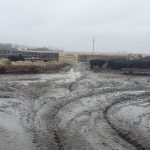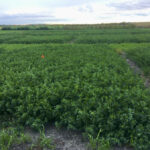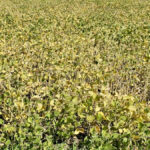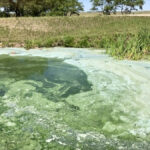Grazing corn stalks is one way farmers and ranchers can reduce the cost of wintering beef cows. However, “grazing corn stalks” is a bit misleading, as cattle shouldn’t be forced to graze the stalk of the corn plant, say North Dakota State University Extension specialists. “The components of the corn plant remaining post-harvest include the stalk, leaf, husk,

Extend the grazing season with corn stalks
Technique requires proper considerations for nutrient content and stocking rate

Now is the time to estimate winter hay needs
Getting a handle on waste can reduce losses and save money
Harvested forages are a critical component of winter feeding programs for many cattle herds. “Conducting a hay inventory now will give producers a good idea of possible deficiencies and allow time to develop the best options for the upcoming feeding season,” says Janna Block, North Dakota State University Extension livestock systems specialist. The first step

Test forages for nitrate prior to haying or grazing
High temperatures combined with adequate moisture can impact metabolism and cause nitrate to build up in plants
Although much of the region has received adequate moisture this summer, it is important to remember there is still potential for nitrate toxicity in many forage crops, including small grains, brassicas, millet, sorghum/sudangrass and corn harvested for hay. “Nitrate is a common form of nitrogen found in the soil, which is taken up by plants

Reduce muddy conditions for livestock health
With mud impacting many farms and ranches throughout the region, North Dakota State University Extension specialists offer tips for protecting livestock health and managing muddy conditions. “When cattle get wet, their hair lies down and loses insulation value,” says Zac Carlson, NDSU Extension beef cattle specialist. “Mud will further reduce the insulation value of hair coats. Cattle become chilled quicker

The ins and outs of late-season alfalfa
With late-summer rains, alfalfa stands have seen new growth
Due to the impacts of the drought, livestock producers throughout the region are in search of additional feed. “Some areas have received rain in late August and early September causing alfalfa fields to green up,” says Miranda Meehan, North Dakota State University Extension livestock environmental stewardship specialist. “Producers are asking what the risks and rewards

Sudden change in diet may cause bovine fog fever
Caution recommended when changing forage diets in cattle
The summer of 2021 has been very challenging for ranchers and livestock. With severe drought throughout the region, we have experienced the challenges of a reduced amount of forage for grazing and forages harvested for winter feed. “While the recent rains have improved some pasture and late-season grazing conditions, winter feed inventories still remain a

Drought-stressed soybeans offer forage options
Don’t wait too long to make the decision as feed quality is declining daily
Although many areas across the region have received much-needed moisture recently, the ongoing drought and lack of forage options for beef producers is still a concern. “One potential forage source is drought-stressed soybeans that can be grazed or harvested for hay or silage,” says Janna Block, North Dakota State University (NDSU) Extension livestock systems specialist at

Going non-traditional on forage
Tips and considerations for putting up atypical sources of livestock feed
Many producers are seeking alternative, possibly non-traditional, sources of forage such as cattails, flax, kochia, millet varieties and soybeans in light of continued drought. “With limited forage on the market and high prices, it may be a better option to evaluate local hay options,” North Dakota State University Extension beef cattle specialist Zac Carlson said.

Drought-stressed canola possible forage for livestock
It can work as an emergency source, but some risks need to be managed
Drought stress has resulted in poor canola stands that are unable to be harvested. Poor canola stands may provide an alternate forage option. “Livestock producers facing forage shortages may be able to feed their cows canola, provided they take certain precautions,” says Miranda Meehan, North Dakota State University Extension livestock environmental stewardship specialist. “While canola makes palatable feed, it may

Algae blooms can endanger livestock
Hot weather can promote blooms which can produce harmful toxins
Cyanobacteria, also known as blue-green algae, can produce toxins that are harmful to livestock, wildlife and people. The growth of this bacteria is aided by high temperatures. “The hot, dry conditions we are experiencing are perfect for the production of cyanobacteria,” says Miranda Meehan, North Dakota State University Extension livestock environmental stewardship specialist. Given the current conditions, producers and the public should

